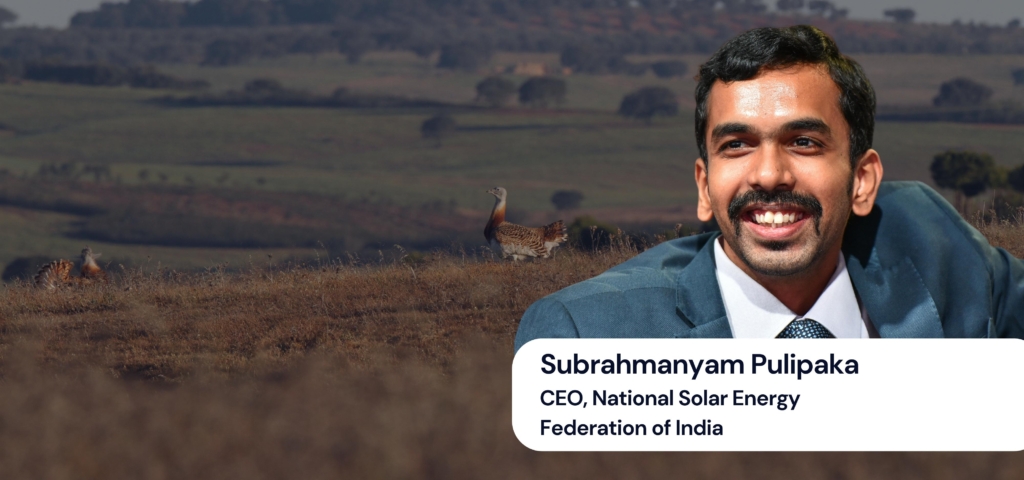In recent years, the renewable energy sector in India has seen remarkable growth, setting ambitious targets for itself and contributing significantly to the nation’s sustainable future. However, with growth comes its own set of challenges, and one issue that has come to the forefront is the delicate balance between green energy projects and ecological preservation. In this blog post, we will delve into the critical issues faced by India’s renewable energy sector, with a focus on land and ecology concerns, particularly the challenges posed by the Great Indian Bustard (GIB), and explore potential solutions to these pressing problems.

Land Availability and Utilization
Subrahmanyam Pulipaka, a prominent figure in India’s renewable energy sector, highlighted the growing challenge of land availability and utilization. While India possesses vast land resources, the development of large-scale solar projects requires the aggregation of numerous land parcels. This process can be cumbersome and slow, leading to delays in project implementation.
Furthermore, renewable energy projects, especially solar installations, typically require arid or semi-arid land. As these lands become increasingly scarce, the renewable energy sector faces the daunting task of locating suitable areas for expansion. Pulipaka emphasized that this challenge is likely to persist as the sector continues to grow.
Great Indian Bustard and Collision Concerns
One of the most pressing ecological issues in the renewable energy sector is the potential collision of the endangered Great Indian Bustard (GIB) with transmission lines in areas where these birds are prevalent. The GIB, native to regions in Rajasthan and Gujarat, is at risk due to solar projects in these areas. Subrahmanyam Pulipaka discussed the efforts to address this issue, showcasing the industry’s commitment to protecting this endangered species.
International Case Studies
To provide context, Pulipaka highlighted international case studies where similar bird collision issues occurred. In countries like the UK, Namibia, and Europe, bird diverters, in various forms, were employed to reduce bird collisions with power lines successfully. These solutions provided evidence that the coexistence of renewable energy infrastructure and bird populations is possible. Importantly, the industry’s intent is not to harm these birds, but to find ways for them to coexist harmoniously with renewable energy projects.
The Challenge of Underground Transmission Lines
One proposed solution to protect the GIB and other wildlife is to place transmission lines underground. However, this approach presents significant challenges. Undergrounding high-voltage lines is technically complex, economically burdensome, and poses safety concerns. Pulipaka explained that undergrounding such lines would increase costs exponentially and could disrupt ecosystems.
Implications for Project Costs
Addressing the concerns raised about the cost implications, Pulipaka emphasized that shifting to underground transmission lines would significantly escalate project costs. Though he refrained from providing specific figures, he highlighted that it would render many renewable energy projects economically unviable. This would not only impact the industry’s growth but also hinder India’s progress in achieving its renewable energy goals.
Stricter Norms for Green Energy Projects
The conversation also touched upon the need for stricter environmental norms and impact assessments for green energy projects. Pulipaka emphasized that India’s renewable energy sector is working towards incorporating sustainability into its operations. Projects are increasingly exploring co-cultivation with vegetation below solar panels to optimize land use while addressing ecological concerns.
A Call for Balanced Policy
Pulipaka urged for a balanced policy environment that considers both the need for renewable energy and ecological preservation. He highlighted the sector’s commitment to initiatives like industry-funded breeding programs for the GIB and the cultivation of crops in arid regions beneath solar panels to promote sustainability.
In conclusion, India’s renewable energy sector is navigating a complex landscape where it must balance the pressing need for clean energy with ecological preservation. Challenges related to land availability, wildlife protection, and policy evolution are at the forefront of this endeavor. While these challenges are formidable, the sector is actively seeking solutions that allow green energy and ecology to coexist harmoniously for the benefit of both India’s future and the planet as a whole.
(Access the complete interview by tuning in to the TIEH podcast available on our website and other major podcast platforms.)


